|
|
review
|
NEW>> Sit Down and Shut Up!
Brad Warner
New World Library 2007
 In his latest installment of musings about his present practice of Zen Buddhism and his past passion for playing bass in a punk rock band, Brad Warner draws comparisons between his interests in a simple and humourous way. Throughout the book, he refers to the Shobogenzo, or Treasury of the Right Dharma Eye, a great work of Zen teaching written by Dogen Zenji in the 13th Century. As a musician and a practitioner/teacher of Yoga, this book was an interesting read as I could relate on many levels. His poignant insights were often amusing, and though his observations on preparing for and playing a show appeared to be mundane, they tied together quite nicely in comparison with the Shobogenzo. In his latest installment of musings about his present practice of Zen Buddhism and his past passion for playing bass in a punk rock band, Brad Warner draws comparisons between his interests in a simple and humourous way. Throughout the book, he refers to the Shobogenzo, or Treasury of the Right Dharma Eye, a great work of Zen teaching written by Dogen Zenji in the 13th Century. As a musician and a practitioner/teacher of Yoga, this book was an interesting read as I could relate on many levels. His poignant insights were often amusing, and though his observations on preparing for and playing a show appeared to be mundane, they tied together quite nicely in comparison with the Shobogenzo.
I am not a practitioner of Zen, though I have a great respect and admiration for it as schools of Yoga and Buddhism share the same roots, insights and practices. With this book, Warner manages not only to entertain but also to educate and interest the reader on zazen, the practice of Zen meditation. To his credit, Warner doesn’t claim to be an Enlightened Zen Master, and it is this sense of humility that kept me interested with the philosophical concepts in the book. The art and technique of Sit Down and Shut Up! require the reader to stop and examine exactly what Warner is speaking about, especially in reference to the Shobogenzo, since a simple sentence of Dogen’s teachings contains a mountain of meaning.
Warner draws on his experience with his past teachers as well when he comments on his transition from musician to student of Buddhism. He uses their teaching techniques, emphasizing awareness, consistency, and patient practice for the benefit of the reader. As he also references reader responses to his first book, Hardcore Zen (which I haven’t read) and provides commentary on them, Warner acts as a beacon, spreading the appeal of Lord Buddha’s teachings to those who might not have gained exposure to them. It is not necessary to read Hardcore Zen to grasp Sit Down and Shut Up!, though Warner’s spiritual transition sounds like a great awakening.
Warner beautifully conveys an ancient philosophy using modern language, slang, and humour while preserving the meaning of the ancient Shobogenzo. Sit Down and Shut Up! is an accessible read for a contemporary society afflicted with short attention spans and minimal yearning for inner exploration.
- Paul Gangadeenback to top NEW>> Transparent Leaves From the Tree of Life: Metaphysical Poems
Georg Feuerstein
Traditional Yoga Studies 2007
 The Consensus Story The Consensus Story
We are all performance artists
acting out The Story
we saw others acting out
since time immemorial.
And now we have forgotten
who we were before The Story
so entranced us.
Georg Feuerstein
Transparent Leaves
An aged cedar tree leaned outside the window of a cabin where I once lived. I regularly sat at the kitchen table to draw it. The first drawings were precise, proportions and detail rendered as exactly as I could make them. Days and weeks passed; the drawings simplified. A simple stroke for a curved frond, a thick line for a branch. I began to understand the Oriental brush artists who practised for years to paint bamboo in simple brush strokes.
These poems of Georg Feuerstein remind me of that process. Decades of his life experience in the study, learning and pursuit of the “big questions” of life have been distilled to an essence. He has expressed the perfume of that process in these poems.
Some of them, like “Krishna’s Dance,” “Shiva’s Grief,” or “Milarepa’s Triumph,” have captured the essential details of story and myth, recounting them the way a wise grandfather might on an evening walk with his grandchild. Others, such as “Nirvana” and “One Light,” approach the great mystery, where words cannot go, yet bring the reader to the edge. And some of the poems, like the one quoted above, have distilled the perennial teachings, to offer a version of timeless wisdom.
In exploring the big questions, Feuerstein does not avoid the uncomfortable issue of environmental responsibility. “Consumers” and “Caveat of Peak Oil” remind that humans can choose to live for greed and personal gain (or can choose otherwise), but whatever choice is made carries consequence.
His own consideration of consequence in relation to the books he has authored (over 30, many classics in yoga studies) led Feuerstein to decide he would not publish any more writings unless a solid, environmentally responsible approach was used. Despite his well-respected and solid authorship, previous publishers would not meet his requirement for a 100-percent environment friendly process. In a recent interview, Feuerstein commented, “Environmentally, time is clearly running out on us….it is simply criminal to not adopt a 100-percent ecologically friendly approach.” Happily, Traditional Yoga Studies met the standards and published the 70 poems contained in this volume.
With the poems from Transparent Leaves, I did what I rarely do (though I know poems are meant to be heard aloud). I spoke them slowly, savouring with ear and mind, and was glad for the choice. Rich and powerful poems are like rich and powerful symbols: they open and open to many possibilities and can’t quite be pinned down to any exact meaning. These “transparent leaves” are like that. I have the book at the side of my desk, I open it again and again, and the poems, distillations to an essence, open themselves unexpectedly each time.
- Alanda Greenback to top Women of the Way: Discovering 2500 Years of Buddhist Wisdom
Sallie Tisdale
HarperCollins 2006
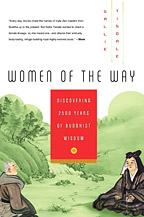 History is subjective and subject to change. The versions of the past we learn are often full of social and cultural biases, which leave certain stories untold and certain voices unheard. If history is the foundation from which we grow, remembering and honouring ancestors is paramount. Sallie Tisdale’s book, Women of the Way: 2500 Years of Buddhist Wisdom, gives voice to a history of women in Buddhism that has long been overlooked. Working from various sutras and historical documents, Tisdale compiles fifty stories about female figures in Buddhism in an attempt to recover some of its women’s history and honour this lost lineage. History is subjective and subject to change. The versions of the past we learn are often full of social and cultural biases, which leave certain stories untold and certain voices unheard. If history is the foundation from which we grow, remembering and honouring ancestors is paramount. Sallie Tisdale’s book, Women of the Way: 2500 Years of Buddhist Wisdom, gives voice to a history of women in Buddhism that has long been overlooked. Working from various sutras and historical documents, Tisdale compiles fifty stories about female figures in Buddhism in an attempt to recover some of its women’s history and honour this lost lineage.
Tisdale, an American Zen Buddhist, began studying and practising in a co-ed setting twenty-five years ago. It was only after several years of practice that she began to see the sexism in her religion, and that equality is not the norm for many Buddhists. She realized that the canon of Buddhist writing was written primarily by and about men. Although she doesn’t believe that the dharma was intended to favour inequality, the reality is that women are often absent, and therefore silent, in Buddhist history.
Tisdale’s solution to this silence is to tell stories of women in Buddhism. She supplements fragments of information from historical documents with her imagination to create a narrative history. The book is divided into five sections: Mythical, Indian, Chinese, Japanese and New Ancestors. In “Mythical Ancestors,” Tisdale works from the sutras (tales that arose from the oral tradition of the historical Buddha and his followers) to tell the stories of mythic female figures. In the sections devoted to Indian, Chinese and Japanese ancestors, she recounts tales of nuns, teachers and other practitioners from these regions. In the section “New Ancestors,” Tisdale focuses on those instrumental in reopening Zen Buddhism to women in Japan, the women who brought Buddhism to the West, as well as teachers she finds inspiring in the West.
Honouring the lineage is very important in Buddhism. In temples, the entire lineage, from the origin of Buddhism to the present, is chanted daily. The chanting represents authority, teaching and connection to the past, as well as the inheritance of religious truth. Tisdale turns to this ancient practice and makes room for a female presence by ending Women of the Way with a chant and dedication.
Teachers are important and their awakening and transformation makes Tisdale’s possible. She acknowledges that her book, and the female ancestors it celebrates, is only a “drop representing an ocean,” since many historical records over the 2500-year history of Buddhism have been lost.
Her act of recovery is more important than the gaps and imaginings it contains. Women of the Way is an impressive collection of narrative history that honours female ancestry, and asserts women’s place in Buddhism as crucial to its history.
– Catherine Paquette
back to top Teaching Yoga: Exploring the Teacher-Student Relationship
Donna Farhi
Rodmell Press 2006
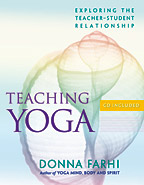 Being a yoga teacher, I need to wear many hats! Some students want me to be a psychologist; others want me to be a priest or a physical trainer; some see me as a holistic healer, a confidante, a father, a son... It's interesting to observe how much my role changes from one student to another. This happens in part because the word “yoga” is quite unclear for many of us. The work of a yoga teacher can be simply to help someone to breathe better, or it can be to help someone reach enlightenment! The ethics involved in teaching yoga are thus confusing and unclear. How then does a yoga teacher draw the limits? How does a teacher create healthy boundaries that will help teacher and student alike? Being a yoga teacher, I need to wear many hats! Some students want me to be a psychologist; others want me to be a priest or a physical trainer; some see me as a holistic healer, a confidante, a father, a son... It's interesting to observe how much my role changes from one student to another. This happens in part because the word “yoga” is quite unclear for many of us. The work of a yoga teacher can be simply to help someone to breathe better, or it can be to help someone reach enlightenment! The ethics involved in teaching yoga are thus confusing and unclear. How then does a yoga teacher draw the limits? How does a teacher create healthy boundaries that will help teacher and student alike?
For me, teaching yoga has been challenging and I’ve had a very steep learning curve. This is why, throughout my reading of Donna Farhi's Teaching Yoga, I kept laughing about my past errors and experience, wishing I had read this book three years ago!
With a very gentle and open minded, yet direct voice, Donna Farhi describes and questions the teacher-student relationship and the ethics of being a yoga teacher. Practical information is interwoven with stories (both Ms. Farhi’s personal experiences and those offered by other teachers), giving the reader good, real-life examples and open-ended questions to reflect upon. The first part of Teaching Yoga clarifies the student-teacher relationship, and the second part touches on the ethics of teaching yoga. The last section is a workbook for teachers to explore their reactions to delicate situations that might arise in a class. I found Farhi’s blend of humour and anecdotal writing invaluable to assimilating the knowledge in Teaching Yoga.
One thing I really appreciate about her writing is that it’s not specific to one style of teaching. Farhi describes teaching techniques and goes directly to the ethical questions behind them. For example, she writes about teachers making physical adjustments by touching students. Farhi doesn't state if she is in favour of or against making physical adjustments, but simply explains her own experience and gives guidance. In order to give the proper tools to the student, this book is filled with questions and reflections that can ultimately teach the teacher how to build a foundation and make good choices.
I recommend this book to any yoga teacher, anyone thinking about training as a yoga teacher, or anyone who has already taught for many years. Teaching Yoga is an excellent resource manual.
– Geoffroy Tremblayback to top Little Yoga and Sleepy Little Yoga
Rebecca Whitford & Martina Selway
Henry Holt 2005/2007
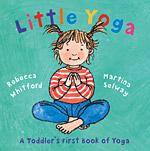 Sam, my two-year-old son, has done yoga as long as he’s been able to walk. As with most kids, it seems to come naturally to him. Sometimes I see him flopping over into a downward dog effortlessly and completely in the moment. Sometimes when he is upset or feeling especially tired, he sinks into the child’s pose, his forehead lolling on the floor. The Little Yoga and Sleepy Little Yoga books were especially written for toddlers, so I thought I’d show them to Sam. Here was the opportunity to try practising yoga together, which we hadn’t done since he learned how to walk and was, thus, too old for mom-and-baby yoga classes. Sam, my two-year-old son, has done yoga as long as he’s been able to walk. As with most kids, it seems to come naturally to him. Sometimes I see him flopping over into a downward dog effortlessly and completely in the moment. Sometimes when he is upset or feeling especially tired, he sinks into the child’s pose, his forehead lolling on the floor. The Little Yoga and Sleepy Little Yoga books were especially written for toddlers, so I thought I’d show them to Sam. Here was the opportunity to try practising yoga together, which we hadn’t done since he learned how to walk and was, thus, too old for mom-and-baby yoga classes.
Sam liked the cute drawings, which are simple crayon lines filled in with bright watercolour textures. Some pages in Sleepy Little Yoga have beautiful backgrounds of trees and leaves made of cutout textured paper collage. In both books, a drawing of a child in each pose is shown with an animal, while a short text reads, for example, “Yoga Baby – curls up like a porcupine.”
As suggested, I did some of the moves myself and encouraged Sam to follow. Some of the drawings provided excellent instruction. Both Sam and I got easily into the Frog (squat), the Fox (kneeling upward stretch), and the Bear Cub (upward raised legs). When I did the Cat pose, he thought I was being a pony and wanted to climb on my back for a ride. The breathing techniques used in the Bee pose were lost on Sam completely, but he probably would have understood them if he were a bit older.
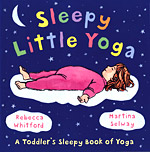 Some of the drawings in these books were unclear and not intuitive. For example, the Owl in Sleepy Little Yoga shows a child sitting on her heels, rubbing her hands, while the text says “Yoga Baby – blinks her eyes like an owl.” I couldn’t tell what I was supposed to do, as there seemed to be no connection between the pose as pictured and an owl’s eyes or body. Luckily, there is an “Explanation of Poses” at the back, which tells me that the Owl pose involves rubbing the hands together and then palming the eyes. There is also a page of photos at the back of real children doing the poses, in case you find that the drawings aren’t sufficient. Some of the drawings in these books were unclear and not intuitive. For example, the Owl in Sleepy Little Yoga shows a child sitting on her heels, rubbing her hands, while the text says “Yoga Baby – blinks her eyes like an owl.” I couldn’t tell what I was supposed to do, as there seemed to be no connection between the pose as pictured and an owl’s eyes or body. Luckily, there is an “Explanation of Poses” at the back, which tells me that the Owl pose involves rubbing the hands together and then palming the eyes. There is also a page of photos at the back of real children doing the poses, in case you find that the drawings aren’t sufficient.
The practice tips given in both emphasize that these books are not meant as manuals, but as a way of introducing your child to a yoga practice, and that parents and caregivers should not look for or expect perfection. But am I really the one introducing Sam? As we try out the poses and mimic the animals, I realize that I am learning from him how to be more effortless in my practice, and how to play.
– Taien Ng-Chanback to top Light & Vibration: Consciousness, Mysticism & the Culmination of Yoga
Swami Sivananda Radha
Timeless Books 2007
 Light & Vibration – a collection of Swami Radha’s final years of work – combines transcribed talks, writings and poetry on Light, edited by one of her close disciples, Swami Lalitananda. In the book, poetry and practical analogies illustrate the interplay between light, vibration and divine consciousness. I found the intimacy of the book accessible and inviting, as Swami Radha shares her thoughts and feelings about her inner journey toward the Light. Light & Vibration – a collection of Swami Radha’s final years of work – combines transcribed talks, writings and poetry on Light, edited by one of her close disciples, Swami Lalitananda. In the book, poetry and practical analogies illustrate the interplay between light, vibration and divine consciousness. I found the intimacy of the book accessible and inviting, as Swami Radha shares her thoughts and feelings about her inner journey toward the Light.
She explains that Light is the subtlest symbol that we have to describe that which has no form – the one source, or the energy that is divine consciousness. She goes on to say that by becoming sensitive to and familiar with vibration, by working with it consciously, we can access this Light.
Swami Radha explains various techniques that help us to connect to the vibration of the Light, or what she calls “the hidden place of the mind.” I learned that through concentrated repetition of mantra, the mind loosens its grip, feels increasingly less threatened by the unknown, and can move from a stance of surviving to that of thriving; the gap that we often perceive to exist between us and the Divine slowly and surely lessens. We become the Light, versus the Light being something that we conceptualize as existing outside of ourselves.
The message is encouraging: We do not have to reach outside of ourselves or be better than we are right now to connect to the Light. It is always inside of us, and accessing this understanding is a matter of listening, clearing away the muddiness of emotion and experiencing authentic compassion. In this way, we begin to discern heart knowing from intellectual knowing.
For me, working with vibration is a new way to relate to my thoughts, feelings and experiences. It’s a way that moves beyond the judgement that keeps me disconnected from myself and from the world around me. Swami Radha proposes that the Light can unite us, that it is the route to peace found beyond judgement. The Light is where peace lies and where our inner and outer realities connect.
Light & Vibration both reinforces and deepens my understanding of a familiar truth: Each one of us has the power to choose and the responsibility to acknowledge just how powerful we are; we owe this to ourselves and to the generations that follow. Coming to understand that we are “powerhouses of energy” has excited and inspired me.
– Beth Moutreyback to top Inside the Yoga Sutras: A Comprehensive Sourcebook for the Study & Practice of Patanjali’s Yoga Sutras
Reverend Jaganath Carrera
Integral Yoga Publications 2006
 Svadhyaya, or study of the self, can take any form of self-enquiry, mindfulness, study of the scriptures or search for divinity in the physical world. Patanjali’s Yoga Sutras remains an essential guide for self-study, and a good translation rests on the bookshelf of most any yogi. Taking the form of short, often poetic aphorisms on the philosophical aspects of mind and consciousness, Patanjali’s sutras are intended to be easy to memorize. Literally translated as “threads,” the Sutras touch on everything from ignorance, to perception, to the nature of Self, God and reality. The sutras, which were transmitted orally from teacher to student well over a thousand years ago, can often seem bewildering to modern-day yogis unfamiliar with the language or intention behind these terse-seeming maxims. Svadhyaya, or study of the self, can take any form of self-enquiry, mindfulness, study of the scriptures or search for divinity in the physical world. Patanjali’s Yoga Sutras remains an essential guide for self-study, and a good translation rests on the bookshelf of most any yogi. Taking the form of short, often poetic aphorisms on the philosophical aspects of mind and consciousness, Patanjali’s sutras are intended to be easy to memorize. Literally translated as “threads,” the Sutras touch on everything from ignorance, to perception, to the nature of Self, God and reality. The sutras, which were transmitted orally from teacher to student well over a thousand years ago, can often seem bewildering to modern-day yogis unfamiliar with the language or intention behind these terse-seeming maxims.
Inside the Yoga Sutras invites us to take delight in Patanjali’s Yoga Sutras, weaving truths with kind, humorous and authoritative writing. A long-time disciple of Sri Swami Satchidananda, Reverend Jaganath Carrera has taught all facets of yoga at universities, prisons, yoga centres and interfaith programs. Here, he unveils the 196 sutras in all their richness. His translation and commentary reveal Patanjali’s great compassion and humanness of voice. With anecdotes, dialogue, witticisms and truths, Reverend Jaganath’s writing entertains and enlightens. He introduces each Pada, or section, of the Sutras with “Key Principles,” “Key Practices” and “Key Terms,” and ends each section with a concise review and a commentary on “What to Do” to apply the teachings.
Reverend Jaganath’s approach emphasizes that the most important teaching behind the sutras is the practice. Along with open-ended interpretations and thoughtful unpacking of each sutra, Inside the Yoga Sutras includes sections entitled “Experience It” that offer concrete advice on how to integrate the teachings seamlessly into daily life. Reverend Jaganath gives methods for structuring a routine of study, while telling students not to be obsessed with progress. He suggests that reading the Sutras become a journey in itself. “Learn to appreciate and enjoy the process,” he says. With extensive cross-referencing, a sutras-by-subject index, a word-for-word sutra dictionary, and a Sanskrit glossary, Inside the Yoga Sutras is a reference and study guide for perhaps the most interesting subject out there: the Self.
When reading this book, I feel like a guide is leading me to step forward on my journey. The map I hold is ancient, but I am dusting off its obscurity with the help of Reverend Jaganath, learning the wisdom embedded there. He has outlined a path not without difficult terrain, but with the compass of faith and purpose, he encourages the aspirant to reach the summit. Like anyone, I have obstacles and faults, and part of the journey involves overcoming them. In this text, Reverend Jaganath convinces me that the answers can be found here, Inside the Yoga Sutras.
– Nancy Millerback to top The After-Death Room: Journey into Spiritual Activism
Michael McColly
Soft Skull Press 2006
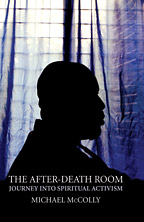 The After-Death Room is a spiritual journey both for the reader and the writer, spanning the globe from west to east and delving into the heart of what it means to be a compassionate human living with AIDS. Michael McColly, an American writer and English teacher who has lived with the disease for nineteen years, travels throughout Asia and Africa to document the work of non-governmental organizations that serve individuals living with AIDS. Along the way, Michael teaches them yoga, as one who has discovered that it can help manage the symptoms of HIV/AIDS and provide peace of mind to the suffering. The After-Death Room is a spiritual journey both for the reader and the writer, spanning the globe from west to east and delving into the heart of what it means to be a compassionate human living with AIDS. Michael McColly, an American writer and English teacher who has lived with the disease for nineteen years, travels throughout Asia and Africa to document the work of non-governmental organizations that serve individuals living with AIDS. Along the way, Michael teaches them yoga, as one who has discovered that it can help manage the symptoms of HIV/AIDS and provide peace of mind to the suffering.
The story travels full circle from Chicago to Senegal, spanning different eras in the writer’s life—first while working as a Peace Corps volunteer, then years later when he returns as a spiritual activist. It is in Senegal that Michael first hears the words “spiritual sickness,” hinting that what he suffers from may not be limited to the physical expression of immune-deficiency, but could be indicative of greater forces of consciousness. As the many stories of those who are living the disease unfold – from men who have sex with men (or MSMs) in India, to teenaged street girls to those in the gay party scene in Thailand – a bigger picture of AIDS emerges.
While he travels, teaching the philosophies and practices of yoga, McColly visits with dozens of NGOs to investigate how they educate the public and provide treatment. Through these encounters, McColly brings to light the complicated politics behind AIDS – from lack of education and effective treatment, to corrupt prescription drug companies, to indigenous healing modalities struggling for recognition. He also makes it clear that the approaches to dealing with this epidemic are as varied as the lives of those living with the disease.
McColly leaves no stone unturned, traveling to monasteries in Vietnam where a monk suggests that the disease is a result of falling away from the practice of dharma and to a treatment centre in Thailand – home of the After-Death Room – where the preserved bodies of patients who have died from AIDS are on display in a morbid museum.
The After-Death Room is frank and honest, sometimes painfully so, as McColly visits his old haunts, succumbs to one-night stands and his subsequent shame. It is this emotional honesty that is the strength of the story, both McColly’s biography and those of the many individuals he meets along the way. My only critique is that he did not go into further depth about the spiritual dimensions of healing, providing more concrete evidence that practices like yoga can benefit those who have HIV/AIDS.
Notwithstanding, the book is a touching read and includes a comprehensive resource guide of AIDS NGOs around the globe. This book serves as a useful guide for those in the field and a compassionate story that will expand the heart and mind of any reader.
– Kelli Hanrahan
back to top
|
|